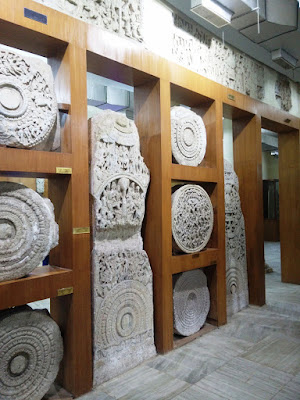This
essay makes two points. The first is to introduce the art of Amaravati, in the
words of Prof Swaminathan, in a document prepared to suggest improvements to
the Amaravati Gallery in the Egmore Museum. The second is to highlight how
exquisitely those words have been chosen and what a marvel the document itself
is. I wrote earlier that Prof Swaminathan had developed a new form of
literature – Powerpoint Literature. This perhaps could be called Bulletpoint
Literature. It shows how marvelously and concisely a document can be drafted, while
comprehensively capturing the historical, artistic, aesthetic significance of
the subject, and also mentioning its unique aspects.
Amaravati
was the location of one of the most magnificent Buddhist stupas in India, and
perhaps the most magnificent in South India. It’s believed to be near
Dhanyakataka, a capital of a Pallava dynasty (related to the more famous later
Pallava dynasty that ruled from Kanchipuram in Tamilnadu). It’s near Guntur in
Andhra Pradesh. Very little of the stupa, called a mahacetiya, remains today, except
a large brick mound, and a few of the limestone panels that decorated it. In
the early 19th century, Colin Mackenzie rescued some of the panels from
a local zamindar, which he then shipped to Calcutta. The best preserved of
these were then shipped to the British Museum in London (like the more famous
Elgin Marbles). A number of damaged panels called the Eliot Marbles, after
Walter Eliot of the Madras Literary Society, were then shifted to the Egmore Museum
in Madras by the museum’s founder Edward Balfour.
 |
| What's left of the Amaravati Stupa |
 |
| Remaining panels at the Amaravati Stupa |
 |
| Amaravati Gallery at Egmore Museum, Madras |
Here,
verbatim, is Swaminathan’s comments on the Importance
and Uniqueness of Amaravati
The
art of Amaravati is a treasure for the following reasons:
·
Here
we witness the earliest lithic work of any significance in the southern part of
the peninsula
·
Even
this earliest attempt exhibits an astounding creative maturity, and represents
the perfection of the art of sculpture
·
The
beginning of Indian classicism is seen here whose thread is to be followed by
the Guptas in the North and the Pallavas in the South
·
It
is here we see the greatest efflorescence of Buddhist art in the medium of
stone
·
There
are jatakas that are narrated here have not been handled elsewhere
·
The
quintessence of Amaravati art is subtle suggestion, and emphasis through
contrast, in depicting the fight of conscience against sin, in showing in the
same frame a king who becomes a monk, almost in sutra form
·
The
technique used makes even hackneyed theme which has to be repeated is given an
artistic twist to make it lively
·
The
themes are as many, the decorative element is as diverse, as are the different
technical methods adopted render the scenes effectively
·
A
synoptic method is adopted for narrating a long Jataka tale in a short compass
the Amaravati sculptor has few equals, like narrating the story of Shaddanta
·
The
sculptor possessed with masterly knowledge of composition and balance and
sequences, and here for the first time lighter and deeper etching,
differentiated planes, perspective and distance, and foreshortening are
successfully introduced.
·
It
is puzzling to find inventiveness of the sculptor who has devised his own way
of presentation and the cumulative effect has created a unique language
·
The
charm of this effective language has compelled the attention of subsequent
schools not only in India but even in faraway places like Java
·
Even
the assimilation of foreign elements has been subtle is not blatant as in
Gandhara, Mathura and Kushana
·
The
four periods of the Amaravati art, starting with 200 BCE to 250 CE, is not only
a long stretch but also is important in the chronology of Indian art tradition
Other related
blogs that may interest you
- The stupa at Vaishali
- Mandhata– An Amaravati sculpture (in Tamil) மாந்தாதா – ஒரு அமராவதி சிற்பம்
- Swaminathan’s Powerpoint Literature
- Purnagiri
- Samrat Asoka – book release speeches
- History of Amaravati – Kishore Mahadevan & Nalagiri sculpture –Artist Chandru (video)
 |
| Artist Chandru explains a design, inspired by a flower, to Prof Swaminathan |
thank you, Gopu.
ReplyDelete